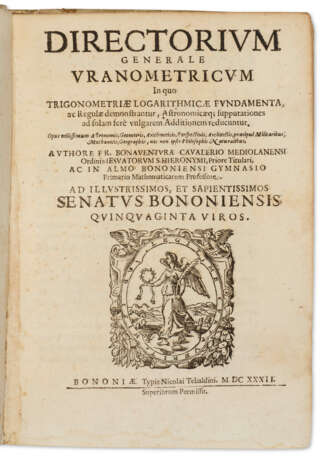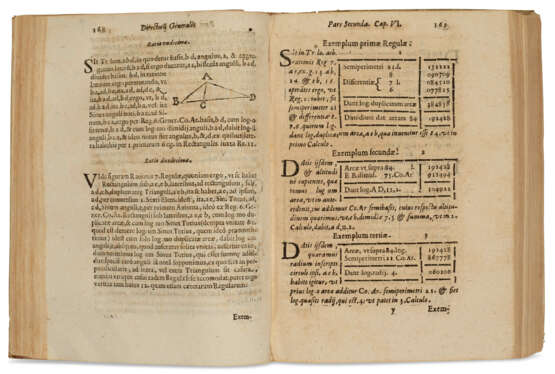ID 887789
Lot 16 | Directorium generale uranometricum in quo trigonometriae logarithmicae fundamenta
Estimate value
$ 4 000 – 6 000
First edition of Cavalieri's first publication. This was the work "that introduced logarithms into Italy, but as it was in Latin, that honor is often given to the author’s later works written in Italian. Besides introducing logarithms, the work deals with spherical triangles, and Cavalieri introduces a new formula for calculating the area of a spherical triangle" (Tomash). The first part introduces the concept of logarithms, and proceeds with detailed examples of their use in astronomy, geometry, perspective, architecture, mechanics, geography, etc. Cavalieri particularly emphasizes their utility in making astronomical calculations. The second part contains extensive logarithmic and trigonometric tables derived from Napier and Briggs.
Cavalieri studied mathematics under Galileo’s friend Benedetto Castelli in Pisa; later he secured the chair of mathematics at the University of Bologna in part through the intercession of Galileo, who wrote a letter of recommendation in which he praised Cavalieri’s mathematical skills, and writing that "few, if any, since Archimedes, have delved as far and as deep into the science of geometry." Cavalieri became one of Galileo’s most important disciples and advocates; he was one of the first Bolognan professors to teach the Copernican theory, and made major contributions to optics, astronomy, and mathematics, particularly to a systematic method of indivisibles that was an important precursor of the calculus. Cinti 91; Riccardi I 332; Tomash and Williams C48.
Two parts in one, quarto (226 x 158mm). Woodcut diagrams in text, large folding table at end (title repaired at inner margin, some faint dampstaining, some gatherings toned). Contemporary limp vellum, lettered in ink on spine (lacking ties, closed split across spine panel).
| Address of auction |
CHRISTIE'S 8 King Street, St. James's SW1Y 6QT London United Kingdom | |
|---|---|---|
| Preview |
| |
| Phone | +44 (0)20 7839 9060 | |
| Buyer Premium | see on Website | |
| Conditions of purchase | Conditions of purchase |





